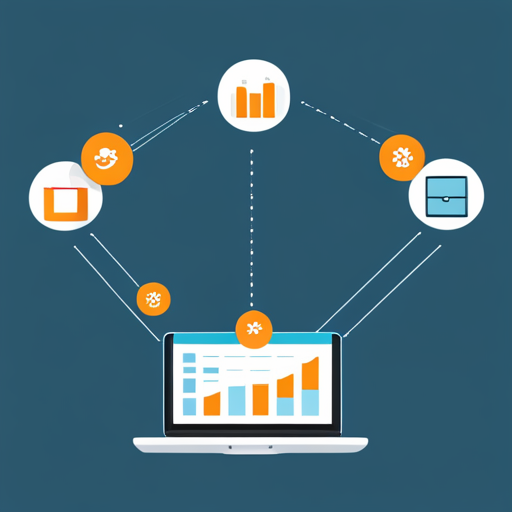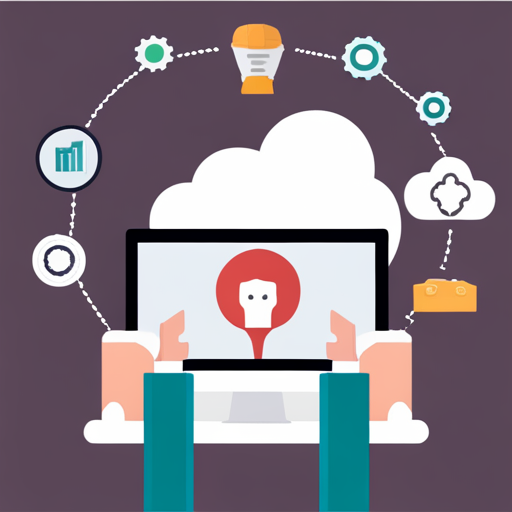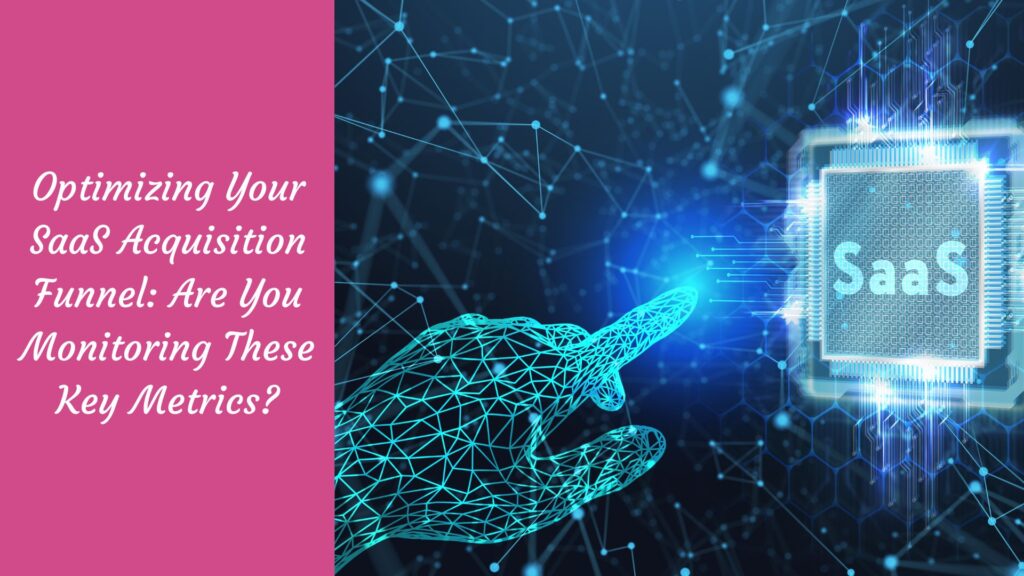In today’s competitive SaaS landscape, fine-tuning your acquisition funnel is more crucial than ever. Effective funnel optimization can mean the difference between a thriving SaaS company and one that struggles to retain its users. However, to achieve this, you need to know what to measure and how to make sense of the data.
📊 This post will guide you through the key metrics that can help optimize your SaaS acquisition funnel, enabling you to outpace competition and accelerate business growth. Let’s dive in and make the most out of every visitor that enters your funnel. 💪🚀
What is acquisition funnel?

The acquisition funnel, often called the “sales funnel” or “purchasing funnel,” is a visualization of the journey your potential customers go through from their first interaction with your brand until they convert into paying customers. For SaaS businesses, this funnel is a crucial component of their customer acquisition strategy. Let’s break down the steps involved in a typical SaaS acquisition funnel:
- Awareness: It is where potential customers first learn about your brand or product – through marketing campaigns, social media, or word of mouth.
- Interest: In this stage, potential customers express an interest in your product. They might subscribe to your newsletters, follow your social media channels, or visit your website to learn more.
- Evaluation: Here, potential customers are comparing your product with others in the market. They might engage with customer reviews, product demos, or free trials to evaluate if your product fits their needs.
- Decision: This is the point where potential customers are ready to make a purchasing decision. They might engage with sales reps, consider pricing plans, or reflect on the overall value proposition of your offering.
- Conversion: The final stage involves the customer making the purchase, subscribing to your software, and hopefully becoming a long-term user.
The transition from each stage to the next is guided by various triggers and actions, which are influenced by your marketing, sales, and customer support strategies. Monitoring key metrics at each stage of the funnel can provide essential insights into your customers’ behavior and help optimize the funnel to improve conversions.
Why is tracking acquisition funnel metrics important in SaaS?

Tracking acquisition funnel metrics is pivotal for SaaS businesses for several reasons:
- Identify bottlenecks: Each stage of the funnel has unique conversion metrics. By tracking these metrics, you can identify bottlenecks and stages where potential customers fall out of the funnel and devise strategies to improve conversion rates at these points.
- Optimize marketing strategies: Understanding your acquisition funnel metrics allows you to gauge the effectiveness of your marketing initiatives. For instance, if your awareness stage has high traffic but low conversion to the interest stage, it might indicate that your marketing message isn’t resonating, leading you to refine your strategy.
- Improve customer experience: Metrics can reveal pain points in your customer journey. Perhaps the evaluation stage has high drop-off rates, indicating that prospective customers aren’t finding the information they need to make a decision. Addressing these pain points can enhance the customer experience and increase conversions.
- Allocate resources effectively: By knowing which stages require improvement, you can allocate your resources—time, budget, personnel—more effectively, focusing on areas that will yield the most significant impact.
- Predict growth: Acquisition metrics can help forecast your company’s growth. For example, if your conversion rates are consistently improving, it’s an excellent indicator of future growth.
Top 5 acquisition funnel metrics tracking tools
In the world of SaaS, understanding and optimizing your acquisition funnel is fundamental. Using the right tools can provide valuable insights to enhance your marketing strategy, customer experience, and conversion rates. Here are the top five acquisition funnel metrics tracking tools that can supercharge your SaaS business.

- Google Analytics: This free, powerful analytics tool provides comprehensive data about your website visitors. From the source of traffic user behavior, to conversion rates, Google Analytics provides critical insights into every stage of your acquisition funnel.
- Mixpanel: Mixpanel is a versatile tool that offers in-depth analysis of your users’ behavior. Its robust features like event tracking, funnel analysis, and retention rates help you understand what drives user conversion, enhancing your user experience and marketing efforts.
- Kissmetrics: This is another excellent tool for tracking, analyzing, and optimizing your digital marketing performance. Kissmetrics provides a detailed view of your customer’s journey, making it easier to identify drop-off points in your acquisition funnel and devise strategies to improve conversions.
- Heap: Heap offers a unique approach to analytics by automatically capturing all interactions from web, mobile, and cloud services. It allows you to measure your funnel performance, track user engagement, and understand user behavior without the need for code.
- Crazy Egg: Crazy Egg offers visual tools like heatmaps, scroll maps, and A/B testing to help you understand your user behavior. It allows you to see where users click, how far they’re scrolling, and what stops them from converting.
Remember, every SaaS business is unique, and the choice of tool should align with your specific requirements and objectives. When used effectively, these tools can provide valuable insights into your acquisition funnel, enabling you to optimize your strategies and boost conversions.
What acquisition funnel metrics should you track at each stage?

Here are the key metrics you should be tracking at each stage of your SaaS acquisition funnel:
Awareness:
- Traffic Source: Identify where your potential customers are coming from – search engines, social media channels, PPC ads, or direct visits. This metric helps you understand which marketing channel is most effective.
- Impressions: Track how many people are seeing your advertisements or social media posts. The higher the impressions, the greater the brand awareness.
Interest:
- Bounce Rate: It indicates the percentage of people who visit your site but leave without taking any action. A high bounce rate could signal that your content is not engaging enough to retain visitors.
- Page Views: Monitor how many pages are viewed per session. If visitors browse multiple pages, it indicates strong interest in your product.
Evaluation:
- Engagement Metrics: Track actions like downloads of white papers, time spent watching product demos, and participation in free trials. These actions denote active evaluation of your product.
- Conversion Rate for Free Trials: Tracking their conversion rate can provide crucial insights if you offer free trials. A low conversion rate may imply insufficient value for users.product.
Decision:
- Shopping Cart Abandonment Rate: Monitor how often users add your product to the cart but fail to complete the purchase. This can help identify potential issues in the purchasing process.
- Sales Engagement: Track the number of interactions with sales reps, frequency of pricing plan inquiries, and any other indicators that a prospect is nearing a purchase decision.
Conversion:
- Customer Acquisition Cost (CAC): Calculate your customer acquisition cost. This includes marketing, sales expenses, and other costs to attract new users.
- Conversion Rate: Track the percentage of potential customers who become paying customers. This metric is a direct reflection of the effectiveness of your acquisition funnel.
By tracking these metrics, you can identify strengths and weaknesses in your acquisition funnel and implement strategies to optimize performance. This data-driven approach will strengthen your position to meet and exceed your business growth objectives.
13 strategies to improve acquisition funnel metrics for your SaaS

Targeted Marketing: Start with a precise understanding of your customer base. Build accurate customer personas and align your marketing efforts to match these personas. This will help you attract the right audience, which is more likely to convert.
Improve User Interface (UI): A user-friendly, intuitive interface can significantly enhance the customer experience. Prioritize user interface design to ensure it’s accessible, engaging, and easy to navigate.
Content Optimization: Ensure your content is rich, engaging, and provides value to your visitors. Using SEO strategies can also improve your website’s visibility, increasing the probability of attracting high-quality traffic.
Offer Free Trials: By providing potential customers with a taste of your service, you make it easier for them to evaluate its value. A free trial can be a compelling incentive for potential customers to move up the acquisition funnel.
Email Marketing: Utilize personalized email campaigns to nurture leads. Regular, meaningful communication can keep your brand top-of-mind and encourage customers through the funnel.
Social Proof: Showcase testimonials, case studies, and positive customer reviews. Social proof can help potential customers feel more confident in their decision to choose your product.
Improve Customer Support: Excellent customer service helps retain existing customers and attracts new ones. Ensure you provide prompt, helpful, and friendly customer support.
Incentives for Conversion: Consider offering discounts or exclusive features to encourage sign-ups or purchases.
Retargeting Campaigns: Implement retargeting strategies to re-engage visitors who didn’t convert on their first visit.
Optimize Landing Pages: Landing pages should be succinct, engaging, and aligned with the specific marketing campaign that directed the visitor to the page.
A/B Testing: Regularly test different elements of your website and marketing campaigns. This can reveal what works best for your audience, enabling you to optimize your strategy.
Automate Your Marketing: Utilizing marketing automation tools can help streamline your processes, making your marketing efforts more efficient and effective.
Monitor and Adjust: Continuously monitor your metrics and adjust your strategies based on the data. This iterative process is key to improving your acquisition funnel over time.
By employing these strategies, you can enhance every stage of your acquisition funnel, turning potential customers into loyal users and ultimately driving your SaaS business growth.
Conclusion
The acquisition funnel is a crucial aspect of any SaaS business. By tracking and improving key metrics at each stage, you can attract, engage, and convert potential customers into loyal users. Remember to continuously monitor and adjust your strategies based on data-driven insights for ongoing success. With these 13 strategies in mind, you can optimize your acquisition funnel and drive sustainable growth for your SaaS business.
We hope these tips have helped you understand how to optimize your acquisition funnel and maximize success for your SaaS business! Good luck!

10+ years experience in Marketing and Operations
